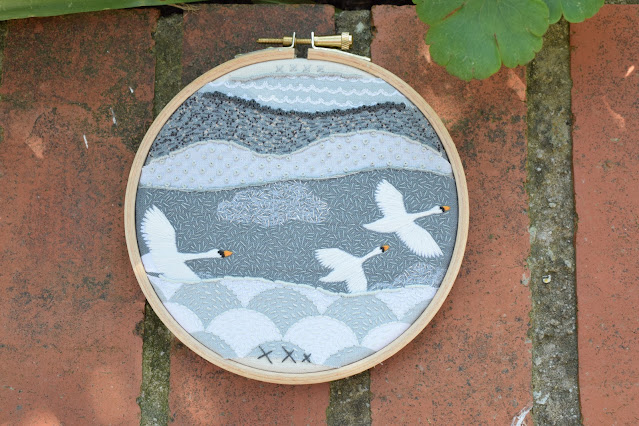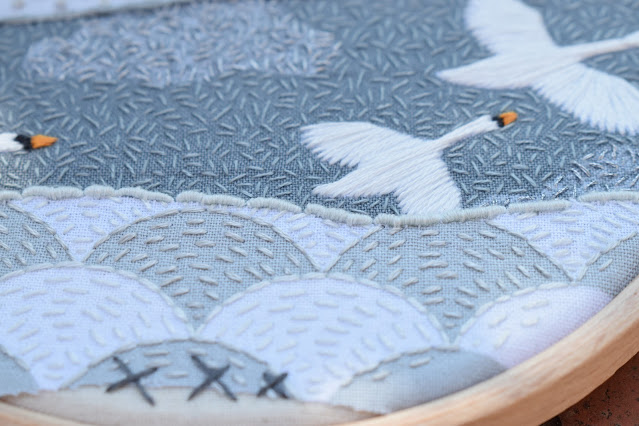It never ceases to amaze me how much love a greyscale Stitchscape gets on social media. I pride myself on being fairly good with colour and confident with colour mixing, spending a long time looking for the perfect combination of colours to make a piece sing and yet it's the pieces I embroider that have nearly a complete absence of colour that really seem to appeal to my followers.
I find working with grey, or black and white, quite challenging actually. It becomes more about the balance of light and dark rather than balancing the colours themselves and using the different tones of grey to create interest. Some greys are warmer or colder, slightly more brown or slightly more blue and they don't all go together well so it's just as important to get this selection right.
I think with this one I actually cheated slightly as a couple of years ago I picked up/was given a pack of fat quarters which had been designed to go together so the grey shade was exactly the same.
If I recall correctly I used three fabrics from this pack, the bottom layer, the polka dot layer and the top wavy layer so the way they were placed has balanced out the two darker fabrics used where it alternates between light and dark and always back to the same shade of grey.
The body itself has one long straight stitch down the centre-ish, from head to tail and then more straight/satin stitches to fill in the gaps either side. I'm not always that willing to call this a proper satin stitch technique as it can be fairly messy and I'm not using the proper technique of passing my needle under the fabric each time so as to always start on the same side for every stitch. I like to save my thread and come up next to where I last put my needle down through the fabric where I can.
You can see, if you look at the previous swan blog posts, how much they have been moved around and are never in the same position. Sometimes I also get confused between which way is the correct way, whether the swans are flying upwards or downwards. I guess it doesn't really matter.
Anyway, this has been a great project to work on whilst I'm on the bus as everything was fairly easy and I could do approximately a layer a day or even, for the smaller layers, a layer in a journey! It takes about an hour to get to work on the bus with all the stops and starts and side roads it goes down, which is a decent time to sit and concentrate on a little project. Because this hoop is only 12cm/5", I just stick it in my rucksack with a small tin of threads and away I go!
Actually, I've just thought this would look really nice if I'd done the opposite colours! Something to think about for next time maybe.
I've couched more metallic strands to the top of this layer, twisted in with some of the cotton floss as well; it's a nice, easy edging that matches perfectly.
I'm not sure if I've made the beaks too big though? The bleed from the print was quite wide so I was trying to catch all of the printed orange under the thread.
The layer above is quite a busy spotted print and I initially toyed with the idea to make tiny one strand, one twist french knots in all of the black spots in this print and then questioned why I would subject myself to such an arduous task (speaking from experience!) and went with a single strand of running stitch instead. I'm glad I did actually because you can still see all of the lovely colours underneath and it has helped to make this piece less 'spotty' overall.
When using running stitch in rows like this I often like to edge from both sides at once, working a line of running stitches following the edge of the below fabric and then also going along the top, raw, edge. As you bring the two lines together it creates interesting little sections where the rows are shorter and meet at angles - it also means that you have nicely edged that top edge ready for a stitched edging to be added, reducing fraying.
I've topped this edge with more bullion knots (love a bullion!) and my little kiss stitches.
I'm interested to hear what you think about the colours here, do you prefer the more colourful Stitchscapes I make, or are you in the greyscale camp? Leave me a comment and let me know!

















No comments:
Post a Comment